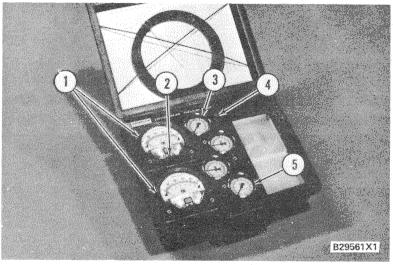
4 minute read
Governor Types
LUBRICATION SYSTEM
One of the problems in the list that follows will generally be an indication of a problem in the lubrication system for the engine.
TOO MUCH OIL CONSUMPTION OIL PRESSURE IS LOW OIL PRESSURE IS HIGH TOO MUCH BEARING WEAR INCREASED OIL TEMPERATURE
TOO MUCH OIL CONSUMPTION
Oil Leakage on Outside of Engine
Check for leakage at the seals at each end of the crankshaft. Look for leakage at the oil pan gasket and all lubrication system connections. Check to see if oil comes out of the crankcase breather. This can be caused by combustion gas leakage around the pistons. A dirty crankcase breather will cause high pressure in the crankcase, and this will cause gasket and seal leakage.
Oil Leakage Into Combustion Area of Cylinders
Oil leakage into the combustion area of the cylinders can be the cause of blue smoke. There are four possible ways for oil leakage into the combustion area of the cylinders:
1. Oil leakage between worn valve guides and valve stems.
2. Worn or damaged piston rings, or dirty oil return holes in the piston.
3. Compression ring and/or intermediate ring not installed correctly.
4. Oil leakage past the seal rings in the impeller end of the turbocharger shaft.
Too much oil consumption can also be the result if oil with the wrong viscosity is used. Oil with a thin viscosity can be caused by fuel leakage into the crankcase, or by increased engine temperature.
MEASURING ENGINE OIL PRESSURE
Tools Needed: 6V3150 Engine Pressure Group or 5P6225 Hydraulic Test Box.
INSTRUMENT PANEL
An oil pressure gauge that has a defect can give an indication of low or high oil pressure.

6V3150 ENGINE PRESSURE GROUP
1. Differential pressure gauges. 2. Zero adjustment screw. 3. Pressure gauge 0 to 1100 kPa (0 to 160 psi). 4. Pressure tap. 5. Pressure gauge 0 to 415 kPa (0 to 60 psi).
The 6V3150 Engine Pressure Group can be used to measure the pressure in the system. This tool group has a gauge to read pressure in the oil manifold. Special Instruction Form No. SEHS7851 is with the tool group and gives instruction for its use.
139
OIL GALLERY PLUG 6. Plug.
Work carefully around an engine that is running. Engine parts that are hot, or parts that are moving, can cause personal injury.

Oil pressure to the camshaft and main bearings should be checked on each side of the cylinder block at oil gallery plug (6). With the engine at operating temperature, minimum oil pressure at full load rpm should be approximately 280 kPa (40 psi), and minimum oil pressure at low idle rpm should be approximately 140 kPa (20 psi).
OIL PRESSURE IS LOW
Crankcase Oil Level
Check the level of the oil in the crankcase. Add oil if needed. It is possible for the oil level to be too far below the oil pump supply tube. This will cause the oil pump not to have the ability to supply enough lubrication to the engine components.
Oil Pump Does Not Work Correctly
The inlet screen of the supply tube for the oil pump can have a restriction. This will cause cavitation (low pressure bubbles suddenly made in liquids by mechanical forces) and a loss of oil pressure. Air leakage in the supply side of the oil pump will also cause cavitation and loss of oil pressure. If the bypass valve for the oil pump is held in the open (unseated) position, the lubrication system can not get to maximum pressure. Oil pump gears that have too much wear will cause a reduction in oil pressure.
Oil Filter Bypass Valve
If the bypass valve for the oil filters is held in the open position (unseated) because the oil filters have a restriction, a reduction in oil pressure can result. To correct this problem, remove and clean the bypass valve and bypass valve bore. Install new Caterpillar oil filters to be sure that no more debris makes the bypass valve stay open.
Too Much Clearance at Engine Bearings or Open Lubrication System (Broken or Disconnected Oil Line or Passage)
Components that are worn and have too much bearing clearance can cause oil pressure to be low. Low oil pressure can also be caused by an oil line or oil passage that is open, broken or disconnected.
Piston Cooling Jets
When engine is operated, cooling jets direct oil toward the bottom of the piston to lower piston and ring temperatures. If a jet is broken, plugged or installed wrong, seizure of the piston will be caused in a very short time.
OIL PRESSURE IS HIGH
Oil pressure will be high if the bypass valve for the oil pump can not move from the closed position.
TOO MUCH BEARING WEAR
When some components of the engine show bearing wear in a short time, the cause can be a restriction in an oil passage.
If the gauge for oil pressure shows enough oil pressure, but a component is worn because it can not get enough lubrication, look at the passage for oil supply to the component. A restriction in a supply passage will not let enough lubrication get to a component, and this will cause early wear.
INCREASED OIL TEMPERATURE
Look for a restriction in the oil passages of the oil cooler. If the oil cooler has a restriction, the oil temperature will be higher than normal when the engine is operated. The oil pressure of the engine will not get low just because the oil cooler has a restriction.
Also check the oil cooler bypass valve to see if it is held in the open position (unseated). This condition will let the oil through the valve instead of the oil cooler, and oil temperature will increase.





